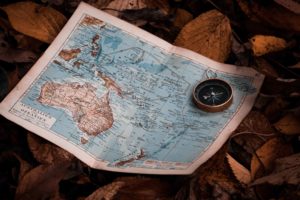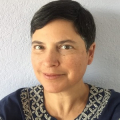You have no items in your cart. Want to get some nice things?
Go shopping
Two decades ago I met a futurist. Maggie wore a peasant blouse over her ruffled skirt, but she didn’t pull out a tarot deck as I’d imagined. Instead, she spread out a map. She drew an index finger up the coastline of Western Australia and marked our location, just east of Geraldton. Spreading across 2.5 million square miles, WA was roughly the size of India but with less than .5 percent of the population. The state covered roughly a third of the continent.
“Everyone claims the Outback as the epitome of this country, but most people cloister in cities along the coast,” she said, pointing to Perth, where two-thirds of WA’s inhabitants resided.
The first Europeans to arrive in 1616 were the Dutch, who deemed the region uninhabitable. It took until the 1820s for British soldiers and convicts to colonise these Aboriginal lands, soon occupied by settlers whose population grew with the advent of the Gold Rush. Most of the state’s land mass lay in the interior – the Great Gibson Desert, the Great Sandy Desert, the Victoria Desert, and the Nullarbor Plain. Only a handful of four-wheel-drive routes ran between them.
We were heading inland via the Great Northern Highway to an international music festival. Wogarno Station, located near Mount Magnet, was a seven-hour trip northeast. Maggie’s friend, Peter, sat at the wheel of the spacious green vehicle, which he had converted from a Christian camp bus. He wore a feather in his Akubra hat and drove shirtless with the windows rolled down. His ten-year-old daughter, Lucy, had travelled with her dad in this mobile turtle shell since she was a toddler. She swept her arm across the map and told me she’d been all over: “I mean, not to every house or anything!” When Lucy was three, she hiked a three-thousand-foot mountain and almost stepped on a python. She’d visited emerald-green swimming holes where blue butterflies were as big as plates. Once, driving across the Nullarbor Plain, they watched it transform into a moving sea of mice. Lucy said she could tell me where all the best sunsets were. When I was her age in California, my only reference to Australia was Olivia Newton John, whose songs I listened to while roller skating around suburban streets in my disco jacket.
“The only thing bad about going away on a trip is that you have to come back again,” Lucy said.
I had spent the last two years, in my early thirties, working as a nanny to save money for a seven-month trip to Australasia. Midway into my travels, I hooked up with this trio through a mutual friend whom I met upon arrival by rail from Adelaide. Susan, who had mustered livestock at sheep stations up north, was now at middle age facing the uncertainty of not having a retirement plan. While we swam in the aquamarine waters of the Indian Ocean, she spoke of the social pressures to settle down and prepare for the future as if it were a knowable thing to be tamed. She worried about someday becoming infirm or homeless. Rather than resist the image or make decisions driven by her fear of it, she meditated on its possibility. I could relate. Without a permanent job or home, I had no plan of my own.
While my bus mate Maggie wasn’t exactly a fortune teller, she did make predictions about the future of the earth and our human place in it. She worked as an advisor on shaping policy, from individual businesses to governments, by examining environmental, social, and cultural trends of sustainability on the planet. During the drive, she described some of the current ecological problems facing Australia.
The land was so old in places that it had eroded away into flat, dusty plains. There were no ungulates, or hoofed animals, native to it. Overgrazing by sheep and cattle eradicated much of the fragile flora that once grew wild. Many introduced grazers went feral, including camels, horses, and hardy goats that ran in herds and compacted the soil, as well as cats and rabbits that further endangered native plants and animals. Overfarming with pesticides contributed to the water shortages, infertile soil, and increasing salinity the ranchers faced. Deforestation and chemical fertilisers caused the salt content of the undersoil to quickly rise to the surface, destroying crops and grazing land. Peering out the windows, Maggie pointed out vast circles of white spreading into the red earth like chalk drawings on a sidewalk. The levelled terrain stretched for miles on either side, punctuated by the peeling trunks and branches of the bloodwood trees.
Folding up the map on the table between us, Lucy tried to teach me how to play chess, but the open windows blew hot air all around the bus and the pieces kept falling down. Finally, we gave up the game. The dust was relentless. It stirred in our lungs, our hair, our eyes.
We passed establishments with names like Digger’s Diner and Swagman’s Rest. At a petrol station I browsed through a selection of CDs with beer drinking favourites. The prior week, three pubs shut down after too many fights broke out. We stopped for lunch at a roadside truck and swatted at black flies.
On arrival at Wogarno I set up camp, pitching my tent near my makeshift family. The sunset painted pink streaks across the bus windows. We settled into fold-up chairs and watched the sheep station transform into a bustling village. Drums called in the distance, accompanied by the cadence of clapping rattles and an accordion in syncopation with a didgeridoo. Fire dancers twirled under the stars.
In the morning, sleeping bags rustled and zipped. I heard coughing, a child crying, footsteps on gravel. “Want a cuppa?” someone asked, clanging a teapot. Somewhere a radio announced news from beyond: “Bush administration; suicide bomber; we must carefully consider the consequences . . .Zimbabwe’s ruling party; aftermath of elections; rocks, teargas, automatic weapons . . . In Perth, four rounds were fired; car crashes, murder charges, all drug related . . .
And now with sports . . .”
“Are you too old for an egg hunt?” Lucy asked me. It was Easter Sunday. We scrambled to find foil-wrapped chocolates hidden in the brush. After breakfast we boarded sheep carts towed by pickup trucks. Standing room only. I held on tight to the rickety wooden side rails as we jostled against one another and ducked under brittle branches on the rutted road to Lizard Rock. Sitting atop the outcropping, we listened to the haunting melody of instruments improvised from tin cans and iron pipes that mimicked the wind.
Later I took a walk under the blaring sun, staying close to the road so as not to get lost. My shadow accompanied me past a broken windmill and metal sculptures made from rusted farm implements. Stretching out under a bit of shade, I watched ants that seeped from the iron-rich pores of red earth.
In the evening I braided Lucy’s hair, weaving the plaits with festive ribbons. Members of a samba troupe painted their faces with glitter to match their shimmering metallic costumes. Their feathered headdresses and hips tilted to the beat of the agogo, snare drums, tambourines, and sordo – a bass drum that extended from waist to toe. I, too, would soon dance with a local samba troupe after returning home, and the spellbinding rhythms would return me several times to my birth country of Brazil. But I did not yet know this.
I asked Lucy where in the world was her favourite place to go. “I liked Disneyland,” she replied, “but Paris is unique. It has things like frog’s legs to eat.”
We watched the shearing shed transform into a stage, floodlit in red. A silent film flickered onto the corrugated siding with images of a Chinese city while a percussion installation imitated urban street life. Another group performed Strings Attached with ropes connected to drumsticks, which formed waves of electric light, matching the motion with sound. The samba band played a mesmerising finale as magenta hues melted into the horizon. Strands of tinsel whirled past in a gust of wind. The future remained unclear. But as I gazed up at the Southern Cross traversing a distance of nearly 20 million years at the edge of the Milky Way, it was still full of possibility.

About Nicole R. Zimmerman
Nicole R. Zimmerman holds an MFA in writing from the University of San Francisco. Her work has been nominated for a Pushcart Prize and Best American Essays, and appears in literary journals such as Sonora Review, The Rumpus, Hypertext Review, About Place Journal, and Creative Nonfiction. She lives with her wife on a farm in Northern California and leads writing workshops.
- Web |
- More Posts(1)




